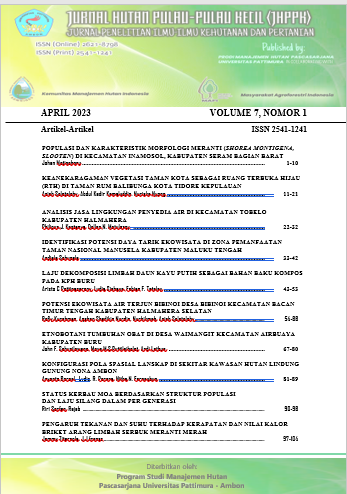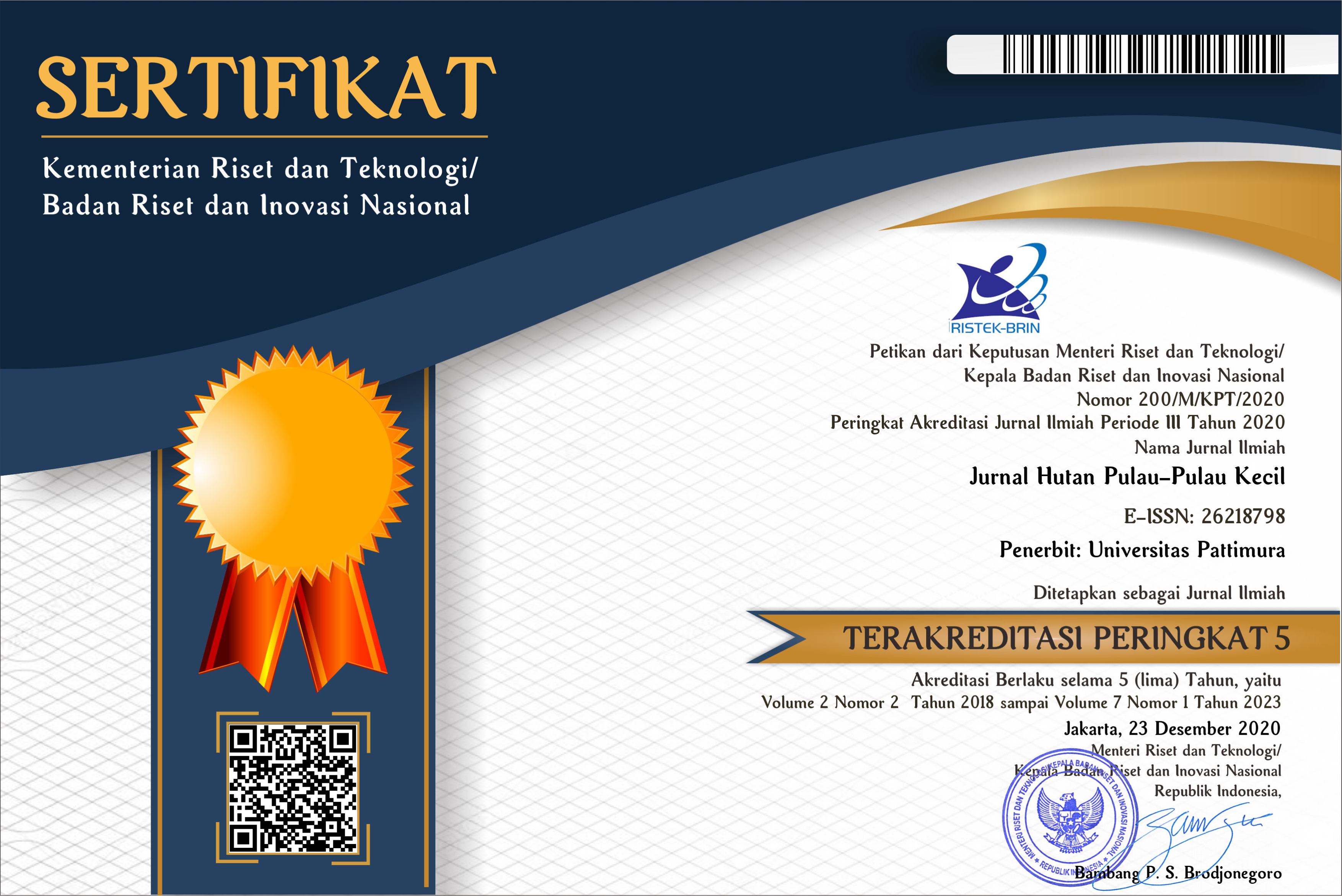PENGARUH TEKANAN DAN SUHU TERHADAP KERAPATAN DAN NILAI KALOR BRIKET ARANG LIMBAH SERBUK MERANTI MERAH
Abstract
This study aims to determine the effect of pressure and temperature on the density and calorific value of red meranti sawdust charcoal briquettes (Sorea. selanica). This study used a factorial complete randomized design with 3 replications. Factors used are A factor (pressure 1 ton, 2 tons and 3 tons) and B factor (temperature 100ºC, 200ºC and 300ºC). The results showed that the highest density based on the pressure factor (A) was 3 tons (a3) of 0.478 gm/cm3 and the lowest was in the 1 ton (a1) treatment of 0.377 gm/cm3, while based on temperature (B) the highest was in the 300ºC temperature treatment ( b3) of 0.479 gr/cm3 and the lowest at 100ºC (b1) of 0.378 gr/cm3. The highest calorific value based on the pressure factor (A) is 2 tons (a2) of 3734.3991 cal/gram and the lowest is in the 1 ton (a1) treatment of 3731.6027 cal/gram, while based on the temperature treatment (B) the highest is at a temperature 200ºC (b2) of 3835.3992 cal/gram and the lowest at 100ºC (b1) of 3732.6028 cal/gram, lower than the Indonesian National Standard. The pressure factor (A) have an effect on the density and calorific value while the temperature factor (B) and the interaction AB has no effect.
Downloads
References
Afina, A., Pato, U., dan Hamzah, F.H. 2021. Karakteristik Briket Dengan Pencampuran Kulit Batang Sagu dan Tempurung Kelapa.Jurnal Sagu, Vol 20 (1), pp:24-28.
Anizar, H., Sribudiani, E., dan Somadona, S. 2020. Pengaruh Bahan Perekat Tapioka dan Sagu Terhadap Kualitas Briket Arang Kulit Buah Nipah.Perenial,Vol 16 (1),pp:11-17.
Badan Standarisasi Nasional. 2000. Standar Nasional Indonesia Briket Arang Kayu. SNI 01-6235-2000.
Falah, M., dan Nelza, N. (2019). Pembuatan Biopelet dari Limbah Tandan Kosong Kelapa Sawit (TKKS) Sebagai Bahan Bakar Terbarukan.Regional Development Industry & Health Science, Technology and Art of Life, Vol 2(1),pp: 90-95.
Gaspersz, V, 1989. Metoda Perancangan Percobaan Untuk Ilmu-ilmu Pertanian, Ilmu-ilmu Teknik dan Biologi.Penerbit ARMICO.
Purwanto.Dj, Utami R.P,dan Suryani.S. 2015. Pengaruh Tekanan Kempa Dan Konsentrasi PerekatTerhadap Sifat BiobriketDari Limbah Tempurung Sawit. Jurnal Riset industryHasil HutanVol 7(2),pp: 1-8.
Hendra, D dan Winarni, I. 2000. Sifat Fisis dan Kimia Briket Arang Campuran Limbah Kayu Gergajian dan Sabetan Kayu.Jurnal Penelitian Hasil Hutan.Vol 21(3),pp: 211-226.
Ishak, I., Lukum. H., dan Arif, I (2012). Briket Arang dan Arang Aktifdari Limbah Tongkol Jagung.Skipsi.
Lutfia. 2011. Potensi Limbah Meranti Merah di Maluku.Fakultas Pertanian. Universitas Pattimura, Ambon.
Mahajoeno, 2005. Briket Arang Salah Satu Bahan Bakar Aternatif. PenerbitTarsito. Bandung.Malik U. 2012. Penelitian berbagai jenis kayu limbah pengolahan untuk pemilihan bahan bakubriket arang. Junal Imiah Edu Research, Vol 1(2),pp: 21-26.
Pari, G dan H. Roliadi. 2004. Alternative technology for theutilization of biomass waste from wood industries.Proceeding of the International workshop on better utilization of forest biomass for local community and environments. Resrearch and Development Center for Forest Products Technology , Bogor.
Purwanto, D. (2009). Analisa jenis limbah kayu pada industri pengolahan kayu di Kalimantan.Selatan. Jurnal Riset Industri Hasil Hutan,Vol 1(1), pp:14-20.
Putra. P.H, Mokodompit, M, Kuntari A.P. (2011). Pengujian Karakteristik Briket Berbahan Dasar Limbah Bambu Menggunakan Perekat Limbah Nasi.Jurnal Teknologi, Vol 6(2),pp: 116-123.
Silalahi, 2000. Komponen Utama Tanaman Biomassa adalah Karbohidrat. Bogor. Hasil Penelitian Industri Deperindag.
Soeparno,1992. Pengelolaan Arang Secara Sederhanaa dan Nilai Panas dari Setiap Kualitas Yang Dihasilkan. Laporan Penelitian. Fakultas Kehutanan UGM dan Depdikbud Yogyakarta. Yogyakarta.
Supriyono, 1997. Komponen –Komponen Pembuat Briket Arang.Gramedia Widiasarana-Indonesia. Jakarta.
Taufik, Y., Violet, V., dan Yuniarti, Y. 2018. Kualitas Briket Arang Dari Limbah Arang Kayu Ulin(Eusideroxylon zwageri Teijsm. & Binned). PT. Citra Prima Utama,Kecamatan Liang Anggang Kota Banjarbaru. Jurnal Sylva Scienteae, Vol 1 (1),pp:1-12.
Wibowo, W.W. 2012. Menghitung Nilai Kalor. Penerbit Kanisius. Yogyakarta.




